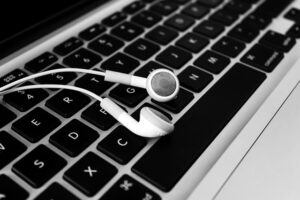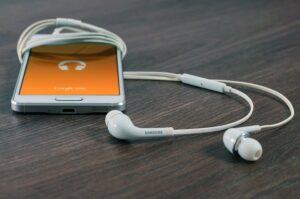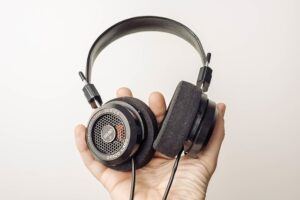Headphones Buying Guide
Table of Contents
Picking the right headphone for your needs can be daunting, given the hundreds of models flooding the consumer market. If you’re in need of a brand new headphone, this guide is meant for you.
It helps to know the differences between the various types of headphones and the features you ought to pay attention to when shopping for a headphone.
Common Types Of Headphones
Whether you’re shopping online or browsing through the different models in a headphone store, you’ll come across these different types of headphones.
Earbuds

Earbuds are tiny pieces of hearing device that tucks right into your ear. The physical structure of the earbud rests comfortably on your outer ear, giving you a decent sound quality.
Lightweight and portable, earbuds can be carried around without much hassle. However, earbuds are notorious for poor noise isolation due to the pieces being rested outside of the ear canal.
If you’re using an earbud in noisy areas like a public commuter, you’ll find the sound being drowned by the environmental noise and you’ll need to ramp up the volume excessively.
In-Ear Monitor

Also known as earphones, the in-ear monitor is sometimes confused with earbuds, due to the similarity in construct. Unlike earphones, the in-ear monitor is designed with an extended piece that can be plugged into your ear canal.
Therefore, in-ear monitors are known to have good noise isolation as there is little to no gap between the earphones and the ear canal. As in-ear monitors are more invasive, it may take a few days before you get accustomed to a new piece.
People use in-ear monitors for its portability, as it can be easily carried around and ideal for working out in the gym as they don’t fall out during rigorous movements. With that said, in-ear monitors may not have the best sound quality as the sound driver is designed to fit the form-factor in mind.
On-Ear Headphones

If you’re not in favor of having tiny pieces of sound-emitting devices nestled or protruding into your ear, on-ear headphones are a decent alternative. As the name implies, an on-ear headphone rests over your outer ear and offers better sound quality.
On-ear headphones are much larger than earphones and earbuds, which means there is ample space to built larger sound drivers. Typically, larger drivers mean an improvement in sound quality.
Unlike over-ear headphones, on-ear headphones are fairly portable as most models can be folded and carried around easily. In terms of noise-isolation, on-ear headphones may not be the best choice as there are gaps between the earcup covering the outer ear.
As the on-ear headphone directly rests over the ear, some people may find it uncomfortable if the headphone is adjusted to clamp over the ear with a certain force.
Over-Ear Headphones

Over-ear headphones are identified by the gigantic padding built on the earcup. Instead of resting on the ear, the thick padding covers the entire ear. Generally, an over-ear headphone is more comfortable as it does not directly compress the ear.
Also, over-ear headphones are known to offer the best sound quality, thanks to the generous space for fitting in better drivers. The tradeoff for having better sound and comfort is the lack of portability.
Over-ear headphones are bulky and they cannot be folded in any way. They are a good fit if you’re when you’re using it on a desktop but it’ll be cumbersome to bring an over-ear headphone into the gym.
Wired Or Wireless?
With wireless technologies dominating almost every type of gadget, is using wireless headphones better than their wired counterparts?
It depends. As convenience as it is, some users prefer the age-old wired headphones. This is because wired headphones are still generally better in terms of sound quality. Besides the driver on the headphone, the sound quality of wired headphones is influenced by the amplifier circuit in the sound card.
On the other hand, wireless headphones depend on the built-in amplifier circuit for sound quality. Often, people who are demanding on sound quality will opt for wired headphones. Besides, there’s no need to worry about battery charging on a wired headphone.
With that said, it can’t be denied that wireless headphones offer convenience and portability. Whether it’s an on-ear or over-ear headphone, the lack of a lengthy wire greatly improves portability. It’s now a usual sight for people wearing wireless headphones while they commute.
When choosing a wireless headphone, it is important to know the underlying wireless technology and battery life. Bluetooth headphones usually work within 10 meters but anything above Bluetooth 4.0 (LE) will allow a distance of up to 100 meters.
As for the battery, a decent wireless headphone ought to last up to 10 hours minimum before it needs to be recharged.
In recent days, wireless headphones are not confined to the larger over-ear or on-ear headphones. True wireless ear-buds which were first introduced as Apple Air Pod, have triggered competing wireless earbuds amongst competitors.
Both earbuds are totally disconnected from each other and they are placed in a recharging case. They are known to offer decent noise cancellation and sound quality. What makes true-wireless earbuds attractive is that you can put it on without being restricted with tangling wires.
Open vs Closed Back

Open-back headphones are designed to expose the driver on the outer surface of the ear cup while closed-back headphones have the drivers totally enclosed. Both types of headphones offer different sound quality due to the physical construct.
If you’re an audiophile looking for realistic sounding headphones, you’ll want to go for open-back. The sound quality is simply better than closed-back. Besides, having air passing through the earcup offers more comfort to the user.
However, open-back headphones are more prone to noise as it lacks the physical blockage offered by closed-back headphones. Closed-back headphones tend to keep noise away, bringing the listener closer to the sound projected from the headphone. This is an important characteristic to project good bass quality.
Check out this article for a better understanding of open vs closed back headphones.
Active vs Passive Noise Cancellation
For people who are insisting on headphones with good noise isolation, the latest active noise cancellation may sound attractive. However, it’s important to understand what active noise cancellation is all about and the limitation of the technology.
Basically, the active noise cancellation relies on a tiny microphone to pick up background noise and produce a waveform that cancels out the noise. The mutually-canceling waveform will suppress background noises like getting stuck in traffic, chatters, or roaring of a plane’s engine.
As active noise-canceling headphones suppress continuous background noise, you’re still able to hear someone talking to you when putting it on. It is undeniably a cutting-edge technology, but the active noise cancellation may sometimes affect the sound quality of a particular frequency.
Active noise-canceling headphones are generally more expensive. If you’re not keen on these headphones, you can check out their passive noise-canceling counterparts. Instead of using special circuitry, passive noise-canceling headphones rely on paddings and sound-proofing material. They are quite effective in muffling background noise.
Other Important Features To Consider
Besides the physical characteristics and technology that made up of the headphones, there are some technical details that can be decisive.
Frequency Response
The frequency response of a headphone refers to the range of sound that can be produced by the driver. Humans are able to pick up sounds between 20Hz to 20,000 Hz. Most headphones are designed to meet this requirement. If you need a headphone with producing good bass quality, you’ll need one that has no problem covering the lower end of the frequency.
Some headphones may feature an extended frequency range that goes beyond the typical range of a human. Depending on your sensitivity, getting a headphone with 15 kHz to 22 kHz may not result in a richer range of sound. With that said, some would argue that having an extended range of frequency results in better lower bass or higher treble.
Impedance
Technically, impedance refers to the resistive force that goes against the electrical current when producing sound in a headphone. Headphones are typically separated into low impedance ( less than 50 Ohm) and high impedance ( more than 100 Ohm).
These values matter when you’re plugging a headphone into the audio source. Having a matched impedance results in better sound quality. Most headphones for portable devices like smartphones or an MP3 player is rated at 32 Ohm. These low impedance headphones work fine on your everyday music players.
High impedance headphones are usually plugged into an amplifier to produce the best sound quality. Professionals usually prefer high impedance headphones as the tighter coil winding results in lesser distortion and hence, better sound.
Ultimately, it’s not merely about the impedance number, but the entire equipment setup that matters. Read more about headphone impedance here.
Driver Types
Regardless of how sleek a headphone may look, the ability to produce sound comes from its driver. A headphone driver is made of components that are put together to generate audio.
Most headphones are built with dynamic drivers as it is the most cost-effective driver. The dynamic driver offers decent bass quality but tends to suffer distortion at higher frequencies. Of course, you shouldn’t write of dynamic drivers as the right engineering design will compensate for the audio distortion.
In-ear monitors generate sound from the balanced armatures driver. This tiny-shaped driver uses electromagnetism to vibrate a diaphragm. Balanced armatures tend to be more focused on a narrow range of frequency, which means an earphone could have up to four balanced armatures to produce the complete range of frequency.
The downside about balanced armature is that they have difficulty in producing bass. Therefore, a dynamic driver is often included in earphones to compensate for the shortcoming.
Planar magnetic driver headphones are known to offer superior sound quality and great bass. They are often used in open-back headphones and are more expensive compared to dynamic drivers or balanced armatures. You can’t drive a planar magnetic driver directly from an audio source as it needs an amplifier to provide a higher current for its vibrating mechanism.
It’s often agreeable that the best sound is produced by electrostatic drivers. Rather than using magnetic coils, electrostatic drivers depend on mutually attracting charges to vibrate the diaphragm. The end result is superior soundstage quality audio with no distortion. However, electrostatic driver headphones are extremely bulky and expensive to produce.
The last driver is making a buzz in the industry, which is known as bone conduction or magnetostriction. Rather than generating sound by vibrating air molecules, bone conduction transfers the vibration to the bone of your inner ear. The bone conduction headphone is popular with joggers as it allows them to be aware of surrounding sounds while tuning in to music tracks.
Sensitivity Rating
A headphone’s sensitivity rating refers to the loudness of sound generated per unit of power. It is defined as a sound pressure level, expressed in decibel (dB) per milliwatt. Most headphones are rated between 80 dB to 120 dB per 1 milliwatt.
Headphone sensitivity doesn’t indicate the sound quality, as it merely shows how it will perform when plugged into different types of audio sources. For example, if you’re plugging a low-sensitivity earphone into a smartphone with low-power audio, you may need to increase the volume towards the maximum.
Other Useful Features
Headphone manufacturers keep pushing for new and improved models that target certain groups of users. Some of these features may be decisive when picking your choice of a headphone.
Sweat and Water Proof
If you’re hitting the gym for long hours, chances are, you will be drenched in sweat. You’ll want a waterproof headphone or earbud that will prevent sweat droplets from seeping in and damaging the driver.
Built-in Microphone
Headphones with a built-in microphone are essential when you’re making calls or playing MMORPG games. While the built-in mics are a far-cry from podcasting microphones, they are sufficient for typical usages.
App Integration
Like many devices, headphones have evolved to merely producing audio. Some modern headphones are built with app integration features that allow connection to digital assistants like Amazon Alexa, simply by pressing a button.
Some high-end headphones also support call management with minimal buttons, You can take calls without removing your mobile phone from your pocket or pouch when you’re working out.
Summary
There isn’t a one-size-fits-all headphone. If you’re an audiophile, you’ll be attracted to higher-end headphones with superb sound quality and zero distortion. On the other hand, getting a typical over-ear headphone below $100 will work for most consumers.
It’s important not to be distracted or confused by fancy jargon or advanced technologies. For example, active noise cancellation suits those who are using it to minimize background noise, but it has little to do with increasing sound quality.
You’ll also need to shop according to your budget. It’s possible to get decent-sounding headphones without spending hundreds of dollars. With that said, high-end headphones are usually more expensive.
Hopefully, this guide has served its purpose in your hunt for the ideal headphone.


